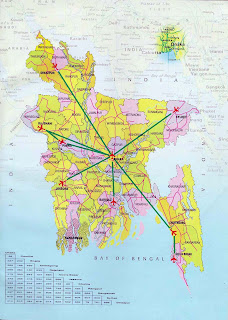মঙ্গলবার, ১৮ আগস্ট, ২০০৯
Meet our beautiful & green Bangladesh

Our Bangladesh has a long and eventful history as a nation. Although it enjoyed as a free and sovereign state only in 1971, after a nine month-long war of liberation, the land itself and its people, have their origin in antiquity. The earliest nation of Bangladesh in found in the 9th century BC Indian epic the Mahabharata. There are evidences of story Mongoloid presence at the time. Then in 5th & 6th century BC came the Aryans from Central Asia and Dravidian's from western India. The Hindu and Buddhist dynasties of guptas, pals and sens ruled the country until 13th century, when Muslim conquerors took over the reigns of the country.
The Muslim rules either belonging to independent dynasties such as the Hussein Shahi or Ilyas Shahi dynasties or Viceroys exercising power on behalf of the imperial seat of Delhi and continued to rule the country until the middle of the 18th century, when the British took over the control of Bengal and eventually the whole of India. The Europeans, mainly Portuguese, Dutch, French and British traders had began to arrive in Bangladesh from the 15th century and extended an economic control over the region.
Bangladesh is populated country of the world. 85% population lives in rural areas. Density of population is about 900 per sq.km. There are about 2 million people of 23 tribes. They dwell mostly in Rangamati, Khagrachhari, Bandarban and in part of northern districts. The tribes have exotic distinct cultures of their own. And the state language and mother toung is Bangla. English is widely spoken and understood. Now a days some young people are learning other languages like French, German, Spanish, Japanese, Chinies etc. for professional purpose. Bangladesh is a land of religious freedom, harmony and tolerance. People of all castes and creeds live here in perfect harmony. The percentage distribution of population to religions is as follows: Muslims - 88%, Hindus - 10%, Christians, Buddhists and others 2%.
The country is officially known as The People's Republic of Bangladesh and has a parliamentary form of Government. The President is the Head of the State while the Prime Minister is the Head of the Government. The country is divided into 6(six) divisions namely Dhaka, Chittagong, Rajshahi, Barisal, Sylhet and Khulna. There are 64 districts, 465 upazillas (small administrative unit) and 85,650 villages under the six divisions.
The Economy is characterized by a large subsistence agricultural sector, which contributes to sum 85% of the country's population and small modern industrial sector. The total cultivable area is around 24 millions acres and there are a little more than 15 million cultivators. Major agricultural crops are rice, jute (the golden fiber), wheat, potato, pulses, sugarcane, tea, onion, garlic, ginger, tobacco etc. Tea, leather, ready made garments, frozen shrimp, jute and jute products are major foreign exchange earners. Export of handicrafts is booming fast. Remittances from Bangladeshis employed abroad are also contributing significantly towards foreign exchange earnings.

